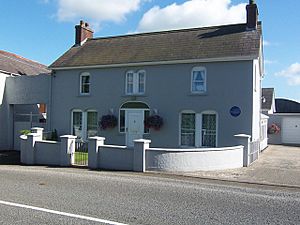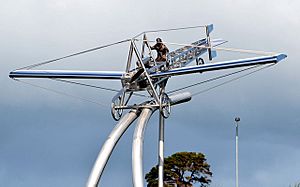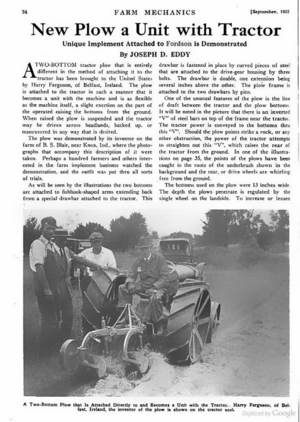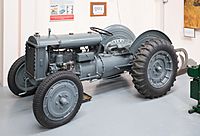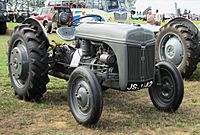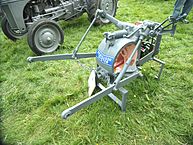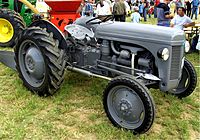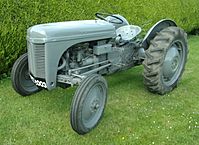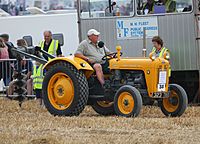Harry Ferguson facts for kids
Quick facts for kids
Harry Ferguson
|
|
|---|---|
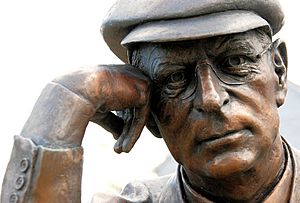
The 2008 sculpture of Harry Ferguson at Dromara
|
|
| Born |
Henry George Ferguson
4 November 1884 |
| Died | 25 October 1960 (aged 75) |
| Nationality | British |
| Known for | Inventor of modern tractor |
| Scientific career | |
| Fields | Engineering |
Henry George "Harry" Ferguson (born November 4, 1884 – died October 25, 1960) was a clever Irish mechanic and inventor. He is famous for helping to create the modern farm tractor. He also invented its special three-point hitch system.
Harry Ferguson was also the first person in Ireland to build and fly his own airplane. Later, he developed the first four-wheel drive Formula One racing car, called the Ferguson P99. Today, his name is still known through the Massey Ferguson company, which makes tractors.
Contents
Early Life and Interests
Harry Ferguson was born in a place called Growell, near Dromore, in County Down, Ireland. His father was a farmer. In 1902, Harry started working with his brother, Joe, in their business. They repaired bicycles and cars.
While working as a mechanic, Harry became very interested in flying. He went to many airshows in other countries to learn more. In 1904, he also started racing motorcycles.
Harry Ferguson's Aviation Adventures
In the early 1900s, young Harry Ferguson was fascinated by the new idea of human flight. He was especially inspired by the Wright brothers. These American pioneers made the first airplane flight in 1903 in North Carolina, USA.
The first person to fly a powered plane in the UK was Alliot Verdon Roe in 1908. But no one had done this yet in Ireland. Harry became very keen on how planes worked. He traveled to air shows in 1909, like those in Blackpool and Rheims. There, he carefully studied how early aircraft were designed.
Harry convinced his brother that they should build an airplane in their workshop in Belfast. Using Harry's notes, they designed a plane called the Ferguson monoplane. After making many changes, they towed their new aircraft behind a car. They took it through the streets of Belfast to Hillsborough Park.
Their first try at flying had problems with the propeller. They kept working on the plane and made more changes. After a week of bad weather, the Ferguson monoplane finally took off from Hillsborough on December 31, 1909. Harry Ferguson became the first Irishman to fly. He was also the first Irishman to build and fly his own airplane.
Building a Business: Tractors and Inventions
After disagreeing with his brother about the future of aviation, Harry Ferguson started his own business in 1911. He sold cars like Maxwell and Vauxhall, and also "Overtime Tractors." Harry saw that it was hard to use a tractor and a plow separately.
In 1917, he invented a plow that could be strongly attached to a Model T Ford car. This invention was called the Eros. It became quite successful, competing with the Model F Fordson.
The Three-Point Hitch System
In 1917, Ferguson met Charles E. Sorensen, who worked for Ford. They talked about how to connect farm tools to tractors so they would work as one unit. In 1920 and 1921, Ferguson showed early versions of his three-point linkage system. He showed it on Fordson tractors in Cork, Ireland, and Dearborn, USA.
Harry Ferguson and Henry Ford talked about putting the Ferguson system on Fordson tractors in the factory. But they didn't make a deal at that time. The first hitch system was mechanical. Harry and his team, including Willie Sands and Archie Greer, soon made a hydraulic (liquid-powered) version. They got a patent for it in 1926.
After some tries, Ferguson started a company called Ferguson-Sherman Inc. This company made the Ferguson plow, which used the special "Duplex" hitch system. This system was mainly for the Fordson "F" tractor. After more years of work, Ferguson's new hydraulic three-point linkage was shown on his prototype tractor. It was called the "Ferguson Black" or "Irish tractor." This tractor is now in the Science Museum in London. A production version of the "Black" tractor, called the Ferguson Model A, was made in 1936.
Ferguson's business joined with David Brown junior's business. Together, they created the Ferguson-Brown Company.
Working with Henry Ford
In October 1938, Ferguson showed his newest tractor to Henry Ford. They made a famous "handshake agreement." Ferguson brought his latest patents for future tractor improvements. These led to the Ford-Ferguson 9N, which was introduced on June 29, 1939. The 1938 agreement meant that the Ferguson tractor should also be made in the UK. This was supposed to happen at the Ford factory in Dagenham, Essex. However, Ford did not have full control there, so Dagenham did not make any.
Henry Ford II, Henry Ford's grandson, ended the handshake agreement on June 30, 1947. This happened after talks with Ferguson did not go well. Ford continued to make a tractor, the 8N, which used Ferguson's inventions. Most of Ferguson's patents had not yet run out. This left Ferguson without a tractor to sell in North America.
Ferguson sued Ford, asking for money because his business was harmed and Ford used his designs illegally. The case was settled out of court in April 1952 for just over $9 million. The lawsuit cost Ferguson about half of that money and caused him a lot of stress. By 1952, most of Ferguson's important patents had expired. This meant other tractor makers could also use his inventions, which they did. A year later, Ferguson's company joined with Massey Harris to become Massey-Harris-Ferguson Co., later known as Massey Ferguson.
Other Ventures
Since the Dagenham factory didn't make the tractors, Harry Ferguson made a deal with Sir John Black of the Standard Motor Company. They agreed to use their armaments factory in Coventry. Production of the newest Ferguson tractor, the TE20, began in autumn 1946. By the end of 1947, over 20,800 TEs were built. To help with sales in the US, thousands of TEs were shipped from England.
In October 1948, production of a US version, the TO20, started at a new plant owned by Harry Ferguson Inc. This left the UK plant to supply tractors to the rest of the world. Ferguson's research team also developed various cars and tractors. This included the first Formula One four-wheel-drive car, made by Ferguson Research Ltd..
Four-Wheel Drive Systems
Ferguson's four-wheel drive system used a special central gear. This system was used in Formula 1 race cars. It was also used in the Range Rover and later in constant four-wheel-drive Land Rovers.
Memorials and Recognition
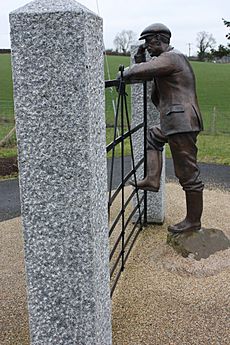
A special blue plaque honoring Ferguson is on the Ulster Bank building in Belfast. This was once the site of his showroom. A granite memorial has been put up in Newcastle to remember Ferguson's first flight. You can see a full-size copy of the Ferguson monoplane and an early Ferguson tractor and plow at the Ulster Folk and Transport Museum at Cultra.
In 1981, Ferguson was honored when his picture appeared on stamps issued by the Irish Post Office. In Northern Ireland, Danske Bank prints its own £20 notes. These notes show a picture of Ferguson next to a Ferguson tractor.
In 2008, the Harry Ferguson Memorial gardens were officially opened. They are across from the house he lived in, just outside Dromara, Co. Down. A life-size bronze statue of Ferguson, made by John Sherlock, stands in the garden. It shows Ferguson leaning on a fence, looking at the view. The gardens are open for everyone to visit.
The University of Ulster opened the Harry Ferguson Engineering Village on February 18, 2004. This was to recognize his important contributions to engineering and new ideas in Ireland.
The Science Museum in London has one of Harry Ferguson's prototype tractors on display. It was finished in 1935. It is part of their history of agriculture exhibition. Information panels explain how he changed the use of farm tractors and their impact on modern farming.
See also
 In Spanish: Harry Ferguson para niños
In Spanish: Harry Ferguson para niños
- Abbotswood, Gloucestershire, country house and estate purchased by Ferguson in 1946
- Ferguson Company


